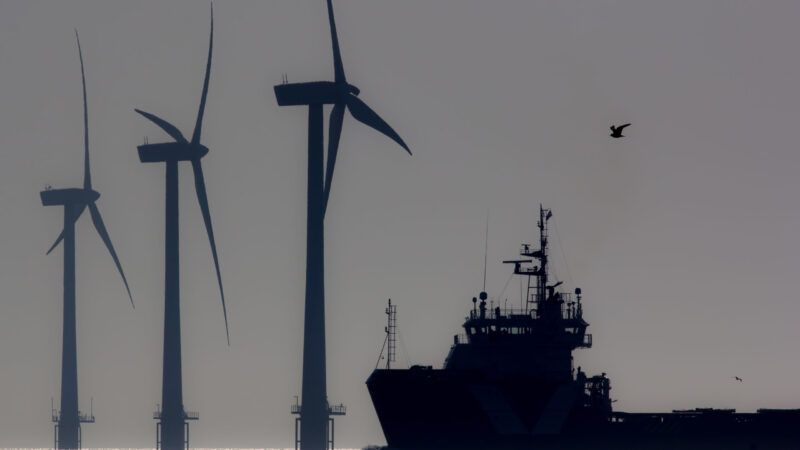Federal Shipping Regulations Sank One of America's Biggest Offshore Wind Projects
Yup, blame the Jones Act. Again.

Construction of an offshore wind farm that had the potential to power more than a half-million homes was canceled in late October, and a famously bad federal shipping regulation seems to be the prime culprit.
When Ørsted pulled the plug on the Ocean Wind project that was planned for the New Jersey coast, the Danish energy firm said in a statement that the decision was driven by "high inflation, rising interest rates, and supply chain bottlenecks."
While some of those things are obviously beyond the immediate control of American policy makers, subsequent reporting on Ørsted's decision to abruptly cancel the project suggests that one factor stood out above the rest. The decision was "based in large part on big delays securing the ship it needed to build the project," Reuters reported last month, citing company officials.
That Reuters report doesn't include a specific mention of the Jones Act—the century-old law that effectively bans foreign-built ships from operating between American ports, and that subsequently drives up the cost of shipbuilding and shipping in the United States—but the subtext is pretty clear. In a call with reporters a few days after the project was canceled, Ørsted CEO Mads Nipper cited "significant delays on vessel availability" caused "a situation where we would need to go out and recontract all or very large scopes of the project at expectedly higher prices."
That's what the Jones Act does. As Reason has reported on many other occasions, the Jones Act is a nakedly protectionist law that severely limits competition in the American shipping market by requiring that ships operating between U.S. ports are American-built, American-crewed, and American-flagged.
Building offshore wind farms requires ships that can deliver supplies to the construction site and some specialty ships that serve as a base for building the turbines. While there are plenty of ships around the rest of the world that can do that work, companies like Ørsted can't use those ships to build wind farms in American coastal waters.
"The Jones Act has essentially created a situation where so many vessels involved in the offshore wind installation process need to be built here, and right now there is only one. So that's a huge constraint," explained Chelsea Jean-Michel, an offshore wind analyst, in a recent episode of Bloomberg's Odd Lots podcast.
Yes, there's just one: a wind turbine installation vessel (WTIV) currently under construction in Texas, which Dominion Energy plans to use to build a wind farm off the coast of Virginia. As Jean-Michel explained, Ørsted hoped to lease it for its own project near New Jersey. But construction of that one, lone American WTIV has been delayed and costs have ballooned.
Colin Grabow, a trade policy expert with the Cato Institute (and notable Jones Act critic) points out to Reason that the original price tag for the ship was about $500 million, but that has risen to about $625 million in recent estimates. Meanwhile, the ship was expected to be finished this year, but delivery is now expected late next year or in early 2025.
"It's difficult to undertake such projects in an efficient manner when the Jones Act–compliant vessels needed for their construction are plagued by rising costs and—in the case of Ocean Wind 1 and 2—don't even exist," Grabow tells Reason.
Indeed, higher fixed costs on things like installation ships might have been manageable—even while being wasteful—with low interest rates. In the current environment, however, it makes sense that energy companies would rethink how they are allocating those investments. It seems like that's exactly what Ørsted did. There are plenty of other countries around the world where it could invest in building offshore wind and not have those projects hobbled by the Jones Act.
What happened with the Ocean Wind project is yet another reminder that the federal government's own rules are the biggest stumbling block to the Biden administration's stated goal of having America produce 30 gigawatts of electricity from offshore wind by 2030.
Faced with the impediments created by the Jones Act, some companies are developing inefficient workarounds, like the Feederdock: a fixed installation vessel that can be served by Jones Act–compliant tug boats bringing supplies from the mainland. There have also been some small cracks in the Jones Act's prohibition against using foreign-built ships for offshore wind projects. Last year, U.S. Customs and Border Protection ruled that foreign-built ships could move crews and work materials to an offshore construction site without violating the Jones Act, which applies only to ships moving "passengers" and "merchandise."
Markets tend to find a way, but the cost of the Jones Act's protectionism is America getting less renewable energy from offshore wind farms that will cost more and take longer to build.


Show Comments (42)